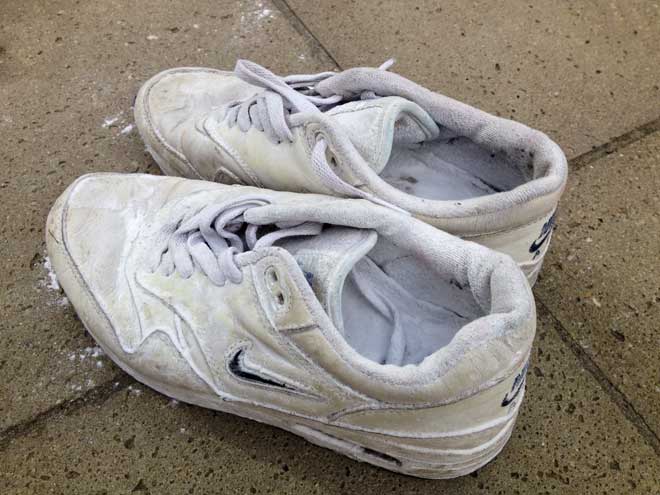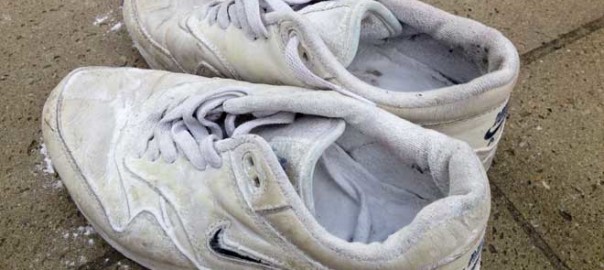So your shoes stink huh? And you heard about people using baking soda to freshen them up.
That’s right, you can de-stink your smelly footwear with Sodium bicarbonate (the chemical name for the stuff).
The fine white powder that is often used for baking cookies (makes them chewy) or as a kitchen sink cleaner is also used in mouthwash and other oral hygiene products and as an alternative for commercial deodorants and antiperspirants containing aluminum and parabens.
No wonder it’s such a well known practice to sprinkle baking soda in your smelly shoes. The method of action is twofold:
- Baking soda is a natural deodorizer.
- Baking soda kills germs.
However, how effective baking soda is as an antibacterial and odor absorber remains unclear.
It is an affordable method (you can buy a pack of Arm & Hammer baking soda for about one buck) but it’s probably not the most effective way of de-stinking your shoes. More in a bit.
How does baking soda work? How does it de-stink your shoes?
Baking soda is known to neutralize bacterial acid, eliminating the stink. Studies show that; one gram neutralizes 12 milli-equivalents of acid.
It’s the acid that the Brevibacteria produce when they are feeding on the sweat on your feet, that causes the foul odor.
two trillion bacteria live on your feet (that’s 12% of all bacteria on the human body)
Baking soda acts as a fungicide and has been reported to cure athlete’s foot. It has antibacterial properties.
How to apply baking soda to your shoes
The drastic way
You can just put half a pack of baking soda in your old shoes or sneakers and leave them for a week or so like I did. (see photo)
I practically stuffed my old Nike Air Max with it and then put them in a plastic bag that I tightly knotted.

These shoes were really stinky and my feet got hot really quickly in them so I thought nuking the sh*t out of them to be the best method. (I kept them in the freezer for a few days with the baking soda in them too)
pros
- baking soda comes in contact with every part of the shoes
- the bacteria have nowhere to hide
cons
- leather and suede shoes may become brittle due to direct contact with the baking soda.
The more controlled way
However, if you have a pair of shoes that you want to keep nice and tidy and don’t want to end up with white residue even after tapping out your shoes frantically, you can use a coffee filter, drier sheet, or a piece of cloth tied together with a string or ribbon.
Pros
- Cleaner. No need to tap out your shoes or finding residu on your socks when you take off your shoes
Cons
- Possibly less effective.
Does it really work?
Despite baking soda being a very popular and widely adapted method for freshening up stinky shoes its efficacy is questioned.
Sodium bicarbonate is known to be a mild antiseptic ineffective against most bacteria.
Regarding potency it’s comparable to the common recommendation of taking black tea foot baths to reduce sweaty feet. It may be effective in case of mild foot odor but for some people these measures just don’t work.
My own findings
After the ‘treatment’ my good old Nikes were fresh and felt clean. For a short while.
Already after a few days (and I didn’t even wear them that much) the smell returned.
Having quarantined my Max’ies for more than two weeks, while keeping them in the fridge as well for a while, should have yielded a better result.
At least, that’s what I thought after hearing so much positive stories about the baking soda method.
What if baking soda does not work for you either?
Like I said earlier, baking soda is sprinkled in shoes to function as a germicide and deodorizer.
Of the many different remedies, sodium bicarbonate is probably the least expensive. The efficacy of the antimicrobial effect on the odor-causing bacteria is unclear.
Arm & Hammer, sprinkled in stinky shoes simply is an adsorbent material that can soak up odors, however, not very effectively.
For both purposes, more effective approaches exist.
Alternative antibacterial agents
Vinegar, for example, shows to be a more potent anti-bacterial agent so washing shoes with vinegar and rinsing them with water afterwards could be a solution. Downside of this method is of course that it’s more time consuming.
Even more adequate ways to get rid of stink in shoes is to use non-natural substances such as TBQ, Vesphene, Clorox, ethanol, and Lysol Antibacterial Kitchen Cleaner.
A variety of commercial household disinfectants were highly effective against potential bacterial pathogens. The natural products were less effective than commercial household disinfectants.
Pure alcohol is more effective in killing off the dreaded bacteria and relatively easy to implement. Rubbing alcohol not only disinfects your shoes but also gets rid of the stench.
Make sure to dry your shoes well, soak them in cleaning alcohol and dry them again. This should get rid of the smell.
Soaking shoes in isopropyl alcohol – found at your local drug store – is an inexpensive and highly effective cure.
Tea tree oil also has potent antibacterial properties that can offer help in combating smelly shoes.
Other ways to purge odor causing bacteria are with ozone, sunlight, UV light, and heat.
Alternative odor absorbers
Alternatives to baking soda are kitty litter (put in a thick nylon), zinc oxide powder, and apple cider vinegar soaks (for both feet and shoes).
Activated charcoal is a better odor absorber than baking soda. Shoe inserts with charcoal may offer a better solution. Cedarsoles are another popular means of reducing odor.
Special cedarsoles are commonly recommended for this purpose because of their antibacterial characteristics.
Here’s an overview of the most popular shoe inserts used to combat smell.
Saddle soap is reported to clean smelly leather shoes on the inside and outside. Especially useful for restoring dress shoes.
Additional advice
Remove shoes periodically to allow them to air out and allow sweat and moist to evaporate. This however does not mean it kills bacteria, just puts them in dormant state. Smell is likely to return in a few days.
Did you use baking soda in your shoes?
Did it work?
Share your experiences below.

Used baking soda to destink black sneakers. Baking soda absorbed through leaving a white residue on outside. Still trying to find a solution to remove residue.
I have some leather shoes that don’t breath at all. I made the mistake of wearing them for months without socks. The smell was getting so bad that I would soon have to stop wearing them at all. I tried febreeze with no luck. Even though it could dry out the leather I decided to put about 1/2 cup in each shoe and spread it around all over the bottom and sides. 24 hours later I poured out the baking soda and couldn’t believe how well it worked… the used baking soda smelled took on the bad smell, but the shoes didn’t! It really had transferred somehow. I’m now back to socks in these shoes and will try the rubbing alcohol trick. I keep some in a spray bottle, so that should be easy enough.
My hubs has this one pair of Columbia hikers that he wears everyday for work. He’s a mover, so constantly on his feet and I’m sure he sweats like no other in them. They smell SO unbelievably bad. His socks, shoes, feet. Every night they make me physically ill from the stench being omitted from them. The baking soda seems to work for a little bit, but just like everything else we’ve tried, (and the list is long…), it wears off quickly and the putrid stench returns. I’ve washed them. Sprayed them. Put bounce sheets in them. Baking Soda. Vinegar. Rubbing alcohol. Numerous stinky feet and shoe sprays. The smell just returns. I’m going nuts!
If this is a real issue and you live in a confinded space buy a big storage box that you can vaccuum seal.